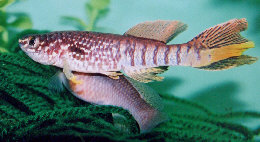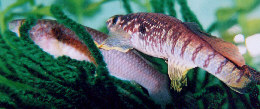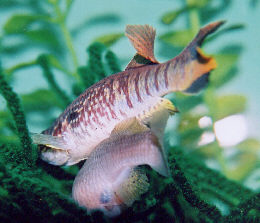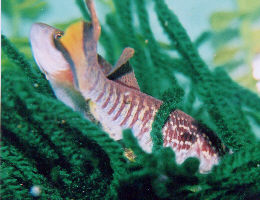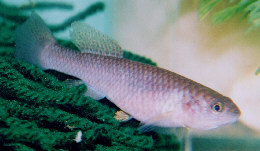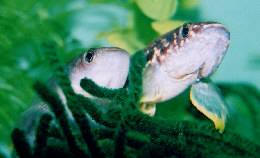| Meaning
of Name |
After
Yngve Sjöstedt, the collector. |
| First
Description |
Lönnberg
A.J.E. 1895 (Fundulus Sjöstedti). Notes
on the fishes collected in the Cameroons by Dr. Y.Sjöstedt. Ofversigt
af Konglar Svenska Vetenskaps Akademiens Förhandlingar 3: p 191-193. |
| Size |
14 cm |
| Meristics |
- D = 17-18, A = 17, ll = 27-28 (Lönnberg 1895)
- D
= 11-12, A = 13-14, ll = 30-32 (Ahl 1924)
- D
= 14-18, A = 16-19, ll = 31-37 (Scheel 1968)
|
| Karyotype |
n = 20, A = 20 (Scheel 1968, 1975) |
| Sub-Genus |
Fundulopanchax |
| Group |
|
| Synonyms |
- Fundulus sjöstedti
Lönnberg 1895
- Fundulus gularis
var A. Arnold 1908
- Fundulus gularis
Blau Fischer 1910
- Fundulus gularis
var. coerulea Boulenger 1915
- Aphyosemion
(Fundulopanchax) coeruleum
Myers 1924
- Fundulus caeruleus
Ahl 1924
- Fundulus
zimmeri Ahl 1924
- Fundulopanchax
coeruleus Stolzenhain 1927
- Fundulopanchax
coeruleum Rachow 1928
- Fundulus
sjoestedti Holly 1930
- Fundulopanchax
zimmeri Meinken 1930
- Aphyosemion
zimmeri Myers 1933
- Aphyosemion
caeruleum Myers 1933
- Nothobranchius
coeruleus Ladewig 1935
- Aphyosemion
coeruleum Arnold & Ahl 1936
- Aphyosemion
sjoestedti Clausen 1966
- Fundulopanchax
sjoestedti Parenti 1981
- Aphyosemion
(Fundulopanchax) sjoestedti
Huber 1994
|
|
Populations
- Dwarf Red
- Fungé
- Lagos
- Loé
- Port Harcourt
- Ndian River
- Niger Delta
- Oteri Delta
- Sapele
- USA (An
import from the USA into France around the early '80's & was distributed
with this name).
- Warri
- CJ 05 - Niger Delta
|

Fp.sjoestedti.
Photo courtesy of Ed Pürzl.
|

A Spanish import
to the 2003 BKA convention.
|
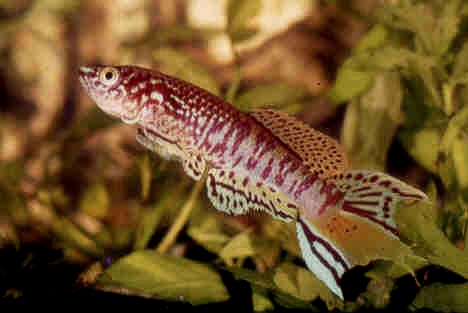
Form circulating in the
BKA early 1980's
|

Form known to be circulating
in the USA.
Photo courtesy of Monty Lehmann.
|
Dwarf Red -
|
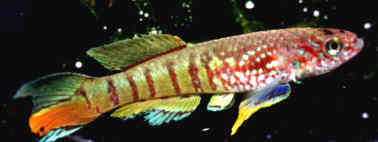
Dwarf Red.
Photo: Roger Gladwell
Note spacing of bars in rear half of body.
|
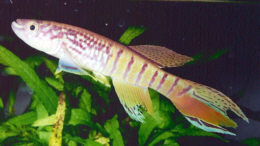
Dwarf Red. Photo
courtesy of Adam Rychlik
|

Dwarf Red. Circulating
in the BKA early 1980's
|
|
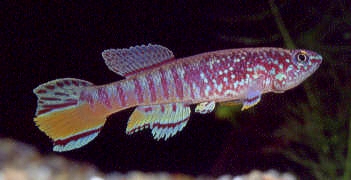
Dwarf Red male.
Photo courtesy of Ed Pürzl.
|
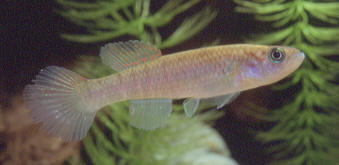
Dwarf Red female.
Photo courtesy of Ed Pürzl.
|
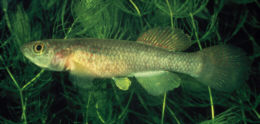
Dwarf Red female
in circulation in the BKA early 1970's
BKA photo.
|
|
|

Dwarf Red in
circulation in the BKA early 1970's
BKA photo.
|
|
Loe -
|
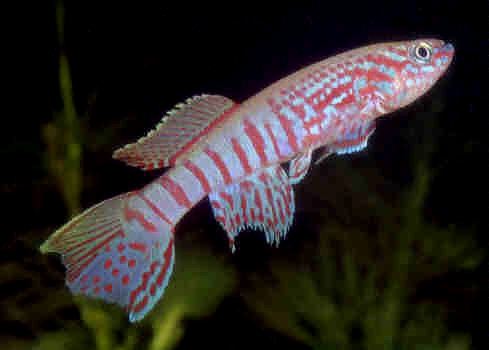
Loé.
Wild male collected by Viktor
Schwoisser near to Fungé. Photo courtesy of Ed Pürzl.
|

Loé.
Wild male as left. Photo courtesy
of Ed Pürzl.
|
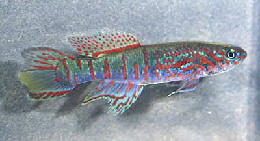
Loe
Photo courtesy of Günther
Schmaus.
|
| |
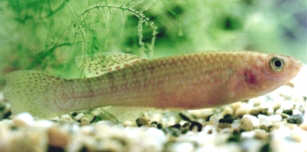
Loé.
Female.
Photo courtesy of Alberto Restrepo Ubach
|
|
Oteri Delta - Seen on Aquabid
from France April 2023.
Warri - This is the accepted
name in the hobby. In reality the location can be seen spelt Wauri
or Waurri. First seen in AKA auctions in 1990 & probably first
imported to the UK in 1992.
Warri is a swamp area. I have talked to a Nigerian working on a thesis
on other species but knows the Warri area. He informed me that the
Warri area is destroyed by petro-chemical industrial activity. It
is highly probable this population is extinct in nature.
An article appears in AKA Journal Sept/Oct 1992. In this mention is
made to a blue & an orange form in reference to the caudal fin.
It has been found that egg production increases when only 1 male is
used in the breeding set up. Sexing out can be as early as 3/4".
Roger Gladwell in BKA newsletter
No.472, January 2005 gives a breeding report. Males were aggressive
to females & they needed 2-3. Over a period of time the eggs became
more infertile & less in number. With these older fish the few
eggs which were good were stored on peat. It was not until 6 months
had past that the eggs started to develop & at a rapid pace. At
6 months & 2 weeks he wet the peat & hatched 4 females &
6 males.
These fish grew well but refused to breed. When they were very old
he put them into 15" deep, planted tanks with a couple of bottom
mops. In this set up they laid a lot of eggs which were put on peat.
These took 5 months of incubation before hatching started.
These fish were raised & set up to breed at a young age. Eggs
from these hatched after 3 months of incubation.
Roger's reference to 15"
deep tanks reminded me of a piece in Amiet's book 'Fauna of Cameroon'
(p162) where he mentions ' In Cameroon, the annuals or semi annuals
which colonise sandy holes can, however, live in slightly deeper water
(in the region of a metre?)'.
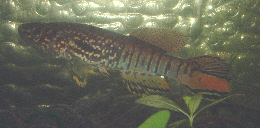
Warri
male.
|

Warri
female.
|

Warri
male.
|
|
|

Warri.
Taken in my fish house by Dick Cox.
|

Warri
male throat pattern.
|
|
| Type
Locality |
A
rivulet near to the waterfall of the Ndian River, western Cameroon. |
| Distribution |
Coastal western Nigeria, Niger delta & the extreme
west of Cameroon where they inhabit areas on sedimentary soils. |
| Habitat |
Raffia swamps, temporary pools & swamp areas &
swampy areas of slow flowing streams. Scheel, in ROTOW
1 considered the extent of there western distribution area was Lagos, Nigeria. |
| Distinguishing
Characteristics |
Not
really likely to be confused with any other species. The caudal fin has
a red / orange colouration in the lower half & the upper half has
spots or lines. Most populations have a wide pale blue outer margin in
the lower caudal fin. The upper outer margin is narrower. |
| Colour/Pattern
Variability |
Medium
/ high |
| History |
Lönnberg described this sp. in 1895 from 2 specimens.
The first specimen (a male) was collected in a small brook near the waterfall
on the Ndian River. The second (a female) was collected from Bonge, west Cameroon.
This specimen was badly damaged. Both were collected by Sjöestedt in 1891-92
who collected them below the falls where the Ndian factory was then located. He
travelled to these locations by boat.
In 1966
Scheel & Clausen attempted to collect them around M'bonge on the Meme River
but were unsuccessful. Scheel considered that Sjöestedt's Bonge was situated
closer to the coast than the present day location of M'bonge, both localities
were on the Meme River.
Boulenger misidentified this sp. & called them
Fundulus gularis
var. coerulea Boulenger 1915.
The
name sjoestedti has been used since 1910 to
describe populations of occidentalis. Again,
Boulenger misidentified a collection from Sherboro Island off the coast of Sierra
Leone as sjoestedti. Also misidentified was
a list of specimens from Akonolinga, east Cameroon. These were referable to batesii.
Krüger reported that Sjöestedt informed him in 1912 that the fish named
after him were caught in the Njong (Nyong) River above the falls some 200 kms
from the sea near a station named Atiga-Samboso. Scheel reported that his book
(published in 1904) contained no information about his visiting the Nyong drainage
between 1890-92 but that he may have been there at a later date. The area 200
km from the coast ( between Akonolinga & Mbalmayo) is an area known to have
A.batesii. Boulenger
gives the following collectors / locations in his 1915 Catalogue.
- 1-5. Collected at Akonolinga, Nyong River, southern
Cameroon by G.L.Bates
- 6-9. Donated to the
BMNH by J.P.Arnold from a Calabar collection.
- 10-11.
Donated to the BMNH by J.P.Arnold from a collection at Sherboro.
- 12-13.
Donated to the BMNH by Mr. A.Rachow from a collection from Axim, Gold Coast
Myers used coerulea
(sjoestedti) as the type sp. for Fundulopanchax.
In 1966 Clausen suggested that all localities west of the Dahomey Gap referred
to as sjoestedti should be named occidentalis
as sjoestedti is known to inhabit eastern
Nigeria & Cameroon. The BKA received fish
from the AKA in 1970 for distribution through the species controller.
History of the synonym Fundulus
gularis var. coerulea Boulenger 1915 Groch
collected the first specimen (a male) kept in aquaria near Warri, western Niger
Delta. This specimen (according to Arnold in 1906) was the first shipment of aquarium
fishes sent from Atlantic Africa. This shipment arrived in Hamburg on the 4th
of November 1905. Arnold maintained this male for about a year & reported
it growing to 4" (10 cm).
Quite a few imports were recorded in these
early years. August 1906: several specimens sent to Germany but all were lost
soon after. December 1906: A female was imported which Arnold had. September 1907:
28 live specimens were imported. Arnold had a pair of 2 colour varieties. He made
drawings of both varieties & sent them to Boulenger along with the 1906 female.
He identified all as gulare.
The first
photograph to be published (in 1908) was taken by Oelze. In the same year Arnold
succeeded in breeding them.
Other imports were receiced into Germany up to
1911 & were called 'var.A (blue)' & var.B.(yellow)'. These names were
recommended by Arnold in 1908. Both varieties were bred by other aquarists.
German breeders were not in agreement with Boulenger's identification but Boulenger
did not change his mind. Boulenger even visited Arnold in April 1911 & saw
the live fish but still did not change his mind. He did acknowledge Arnold in
a note published in 1915 quoting "In a large var.coerulea
(var. A. Arnold) the body of the male is bluish
with red vertical bars & the caudal is yellow in the middle & blue above
& below".
In 1924 Ahl considered them to be a distinct sp. on the
basis of scale count & colours.
In 1924 Myers made coerulea
the type species for the genus Fundulopanchax
( in Aphyosemion).
Clausen, in 1966, considered
coerulea to represent a synonym of sjoestedti.
See also Fp.gularis.
History of the synonym Fundulus
zimmeri Ahl 1924 Ahl described
this sp. from 2 specimens said to have originated from the aquarium trade in Germany
(Berlin Aquarium according to Meinken in 1930). He considered this material to
have been collected from the mouth of the Niger but no evidence was reported.
Meristically they were reported as D=11-12, A=13-14, the size was measured at
7 cm.
Radda examined the preserved fish & reported that the broad bands
on the body were not really broad & neither were they cross-barred as an Epiplatys
sp. |
| Breeding
Notes |
Best maintained in larger aquaria. Eggs can be
layed in bottom mops, peat substrate (which can be dried every few weeks)
or sand. Dry incubation takes about 6 - 16 weeks. Water incubation takes
around 3-6 weeks. Fry are large enough on hatching to take newly hatched
brine shrimp. Growth is quite fast with first signs of sexing out being
observed after 6 weeks.
This is a large species & regular water
changes are advised when growing young on.
Brian Horsfall in BKA Newsletter No. 310, July
1991 recorded the need to put fresh eggs in water with an acid pH as
low as pH 3·8 - 4 for the first few days.
George Mamonov in BKA newsletter No. 335, August
1993 reports incubating the eggs at 18-23°C for around 3 months.
It can take up to 14 hours for htching using melted ice or snow to hatch
eggs at 24-26°C. This water was subjected to UV light for 3-10 minutes.
Fry were sensitive to water changes & would die over pH 7.
|
| Diameter
of Egg |
|
| Remarks |
The dwarf red variety was introduced into the AKA
in 1969 by Mr. Jue. The exact origin of this strain is unknown.
Sterba in Freshwater
Fishes reported that young hatch in 3-9 weeks.
http://www.djramsey.com/tropfish/blue_gularis.htm Dave
Ramsey's page. |






















